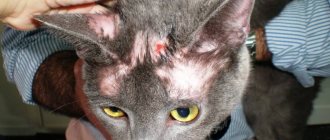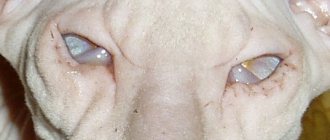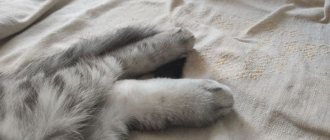12905Administration
1
Fungal infections in cats are quite common diseases. Spores of pathogenic fungi are carried by air and, if the animal’s immunity weakens, quickly lead to the development of disease. It is very important for owners to know the symptoms and treatment of fungus in cats, since only if therapy is started on time, they can eliminate the problem quickly and prevent serious harm to the pet’s health.
Cats always have fungal spores on their skin, and even a pet that does not leave the apartment has them. Being present in the animal normally, spores do not develop and do not lead to problems. If there is a violation of the skin condition, then, in addition to treating the lesion, therapy is also required to increase immunity . When a cat lives in the house, the budget must include an item for the cost of its treatment if necessary.
What is fungus in cats?
Mycosis in cats is a type of disease of the skin and internal organs, which is caused by the activity of pathogenic microorganisms on the body of animals. All cats are susceptible to fungal infections. Living conditions and quality of food do not greatly affect the possibility of infection.
Most often, animals become infected from each other through contact. Although domestic cats that never leave the premises can encounter fungal infection pathogens found on the owners’ outdoor shoes and clothes. The fungus is constantly present on cat fur, but in a healthy animal the pathogenic fungus does not develop and does not lead to the development of infection.
High indoor humidity can contribute to the growth of fungus in cats.
is most often found in kittens and elderly animals, since their immune system does not function fully.
The danger of cat fungus for humans
Fungal infections in cats can be easily transmitted to people if precautions are not taken. Fungal spores easily enter the human body from the fur of an infected animal. And this happens not only from tactile contact, pathogenic fungi are spread throughout the room with the air when scratching.
In addition to the danger of direct contact with an infected animal, human infection can occur through soil, sand or objects on which there may be a source of infection. It is also possible to become infected from a healthy cat, without the presence of pronounced symptoms due to the stable immunity of the animal, which is only a carrier of the fungus.
Organs susceptible to fungal infection
Fungus in cats can affect various organs, but there are general symptoms of fungus in cats , characteristic of all types of fungal infections:
- Coughing;
- depressed state;
- lack of appetite;
- prolonged scratching of a certain area;
- head shaking with ears back;
- dull coat and flaky skin.
Skin fungus
The skin is most susceptible to infection, including fungi, since the skin is the body's primary protective barrier.
Infection with the fungus is possible through the air, orally, or through wounds. The cat's skin becomes covered with scabs, and constantly causes the desire to itch. A characteristic symptom of a skin infection is a change in the structure of the coat: the hairs become brittle and easily break off at the base.
Ringworm in cats can appear after contact with vectors of infection, which are rodents and other animals. It is also possible to become infected through contact with things that have spores on them. The disease may not appear immediately due to the long incubation period. It is characterized by different areas of skin baldness depending on the type of lichen. The skin in areas of baldness becomes red and inflamed.
Ear fungus
Ear fungus is considered one of the most famous infections, which, if not properly treated, can become chronic. The causes of the disease may be:
- Allergic reactions;
- various infectious diseases;
- unbalanced diet;
- congenital and hereditary pathologies;
- injuries and contact with the ear canals.
Symptoms of ear fungus include the following:
- An unpleasant pungent odor and a dark coating on the affected areas;
- constant scratching of the affected area;
- leakage of serous fluid from the ears;
- redness, swelling and pain in the ears;
- irritated or apathetic behavior of the animal.
Claw fungus
The main cause of infection with claw fungus is a paw injury coupled with a weakened animal’s immune system.
Symptoms of the disease may include licking and biting of the paw due to itching in the infected area, discoloration of the claw and redness of the area around it, as well as pain when moving. Often the fungus is not limited to one or a few claws; in advanced forms of the disease, the infection can affect the entire paw.
Fungal eye diseases
Cats often have fungal eye diseases, which are divided into infections that affect the mucous membranes of the eyelids and the eyeball itself. The main cause of the disease is damage to the eye organ and the entry of a foreign body with fungal spores.
The main symptoms of an eye infection include redness and swelling of the eyelids, and excessive lacrimation. In advanced cases, eyelashes may fall out, the area around the eyes will become bald, and purulent discharge may occur.
Atopic dermatitis
Atopic dermatitis is a chronic inflammatory skin lesion. It is caused by allergens from the environment. This disease is associated with an increased reaction of the body to certain substances (dust, pollen, mold). With atopic dermatitis, cats experience severe itching, scratching, skin rashes, and hair loss. If the wound becomes infected, pustules appear. Skin manifestations are found in the head, neck, ears or lower abdomen, between the thighs, and on the chest. This type of dermatitis occurs seasonally and most often affects pets aged 1 to 3 years.
Whether your pet has atopic dermatitis will be determined by your veterinarian after conducting allergy tests. After determining the type of allergen, you should protect your pet from it, which is sometimes impossible to do. In this case, the owners notice that the pet feels better only after moving to another area, for example, out of town.
Treatment is prescribed by a veterinarian after examining the pet and making a diagnosis. It comes down to eliminating or reducing skin itching and inflammation. If it is not possible to protect your pet from the allergen, treatment will continue for life.
Diagnostics
The diagnosis can be determined by the pronounced symptoms of the disease, but for a clearer determination it is recommended to show the animal to a veterinarian. To confirm the diagnosis, it is necessary to take a scraping of the biomaterial for further seeding on nutrient media and subsequent microscopy. In addition, it is possible to determine a fungal infection by illuminating the infected area with a specialized ultraviolet lamp, which illuminates colonies of microorganisms in emerald color.
In addition to the basic research methods, a blood test, examination of smears from the mucous membranes, and microscopy of wool in an alkaline solution to identify fungal spores can be performed.
Treatment of fungus at home
Treatment of fungus in cats depends on the type of infection, the size of the affected area, and the general condition of the animal’s body.
General treatment methods include:
- the use of antifungal shampoos;
- applying topical antifungal agents to infected areas;
- taking antihistamines if there is itching;
- use of a specialized collar to limit scratching;
- oral or injection antifungal medications.
When treating fungus in cats at home, it is necessary to ensure that the animal does not lick recently lubricated areas or scratch them with its paws.
How to treat fungus in a cat at home
| Type of disease | Type of medicine | Name |
| skin fungus | tablets, powders | ketoconazole, moxicillin, terbinafine |
| ointments | clotrimazole, yam, tar ointment | |
| shampoos | nizoral, sebozol | |
| injections | microderm, polyvac, dermicocide | |
| ear fungus | drops | aurizon, oricin, posatex |
| pills | ketoconazole, griseofulvin | |
| ointments | Econazole, Sanoderm | |
| claw fungus | pills | terbinafine, fluconazole, lamisil |
| ointments | clotrimazole | |
| bath solution | enilconazole, chlorhexidine, thiabendazole | |
| eye fungus | drops | tsiprolet, chloramphenicol, leopard |
| ointments | tetracycline |
Traditional methods of treating fungus in cats
To treat skin fungus using traditional methods, you can use an ointment made from honey and fish oil. Mix the ingredients to a creamy consistency and lubricate the affected areas 4 times a day. Another option is to use a mixture of olive oil and lemon juice in equal proportions. Soak cotton wool in the heated mixture and wipe the affected areas 4 times a day. Kerosene can be used for a one-time treatment of the skin when treating bald areas of the skin.
Onion juice is used to treat ear fungus using traditional medicine. Half the onion is grated, and the juice from the resulting mass is dripped into the ear infected with the fungus, 5 drops at night for 5 days.
Treatment of claw fungus in a traditional way involves using a solution of apple cider vinegar, hydrogen peroxide in warm water in the following proportions: 600 ml of warm water, 50 ml of peroxide and 50 ml of apple cider vinegar. The cat's paw infected with the fungus is dipped into the resulting solution and held for 30 seconds, then pulled out and allowed to dry.
To treat eye fungus in cats, it is possible to use chamomile infusion. Brew a teaspoon of chamomile with half a glass of boiling water and let it brew, cool to room temperature and drip 2 drops 5 times a day. You can also instill willow decoction. Cut off the ends of branches without leaves. Dry it and break it into several pieces, put it in boiling water, boil and leave to infuse for 20 minutes, then strain and cool. Apply 2 drops 3 times a day.
Breaking off a claw
Almost always, breaking off a claw is a consequence of lack of claw care. When an animal's nails are not trimmed, they grow uncontrollably and constantly. Because of this, their tissue can become very thin and brittle. With any physical impact (the cat can simply jump unsuccessfully), the claw breaks.
In the best case, the bummer is located somewhere in the middle, in the worst - right at the base.
And in this case, the symptoms are clearly visible and quite characteristic:
If the disease is not too severe, treatment is quite simple:
- The remains of the claw are cut off and the edges are cleaned so that soft tissues are not injured by them. If the claw breaks off near the very base, its remains have to be surgically excised.
- The injury site is washed with a 3% solution of hydrogen peroxide or a weak solution of potassium permanganate.
- If the claw is broken in the middle, nothing else is needed. Otherwise, the wound is cauterized with the same iodine or medical alcohol (or brilliant green, as an option).
The cat should not be allowed outside for at least a week from the start of treatment. It is not necessary for the animal to overload the sore paw and it is impossible for fresh infection to get into the wounds.
Prevention of fungal diseases in cats
Prevention of fungal infections in cats involves creating optimal conditions for keeping your pet. You should not neglect the rules of hygiene, bathe the cat using preventive antifungal shampoos and timely vaccinate animals against fungal infections. It is also necessary to monitor the balance of the diet and monitor the condition of the animal’s mucous membranes, claws and ears.
Fungal diseases are not uncommon and can be easily transmitted between animals. Most diseases respond well to treatment if you contact a specialist on time. To prevent re-infection, it is necessary to completely disinfect the room in which the infected animal was located. It is recommended to bathe your pet using rubber gloves.
Skin ailments in rabbits: how to save a valuable fur coat
This disease is also known as ear scabies. Its provocateur is the tick Psoroptes cuniculi. It parasitizes mainly near the ears, where there is an impressive number of blood vessels that attract these blood-sucking parasites.
This disease poses a danger to animals that are in the same cage with an infected rabbit, and to people. Moreover, fungi affect not only the animal’s fur, but also its skin. The causative agents of this infection are usually Dermatophytes. The cause of the disease may be poor hygiene.
If a rabbit loses its fur, this may indicate the beginning of the molting process, which occurs several times throughout the year. It is worth noting that if the animal is really healthy, then new hair will very quickly appear in the area where the hair has fallen out. Sometimes it even falls out in pieces. During this period, it is very important to monitor your pet and provide him with proper care. It must be combed every day to avoid hair getting into the animal's stomach.










